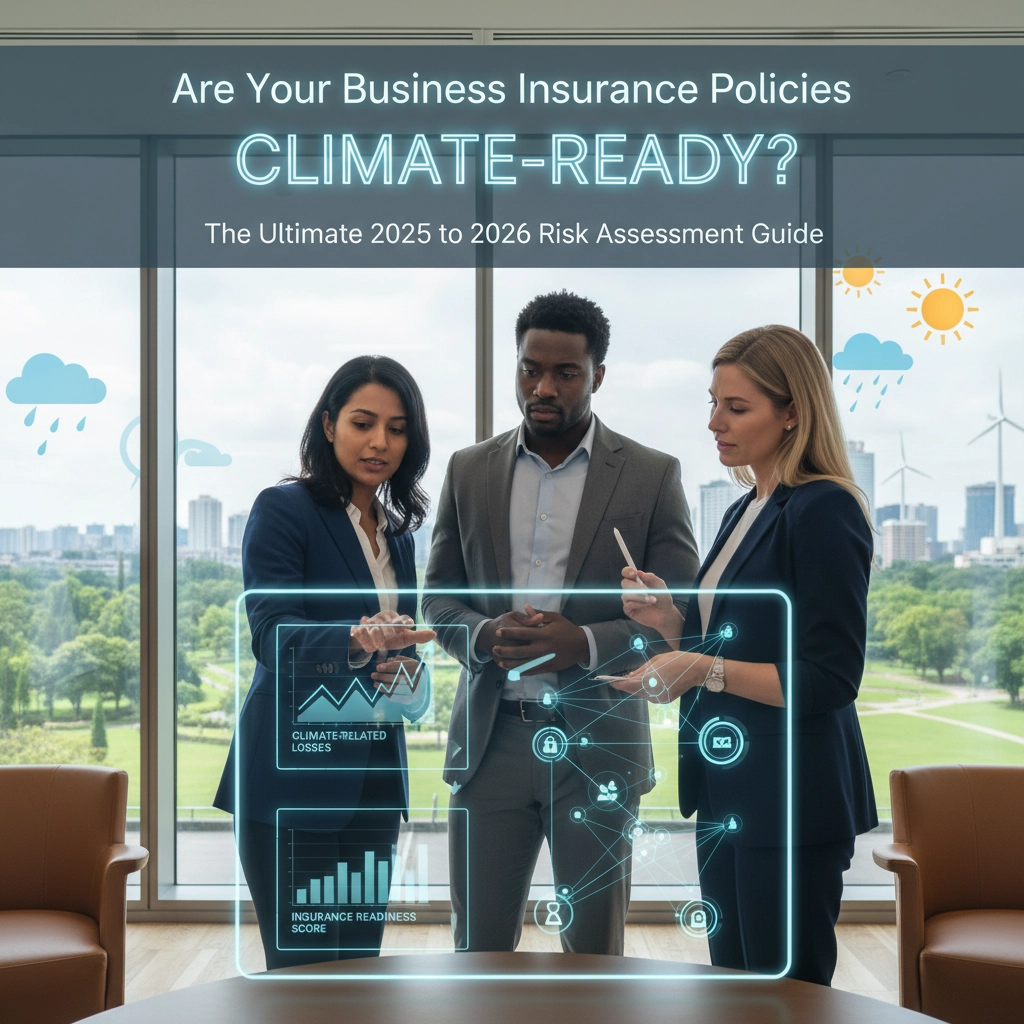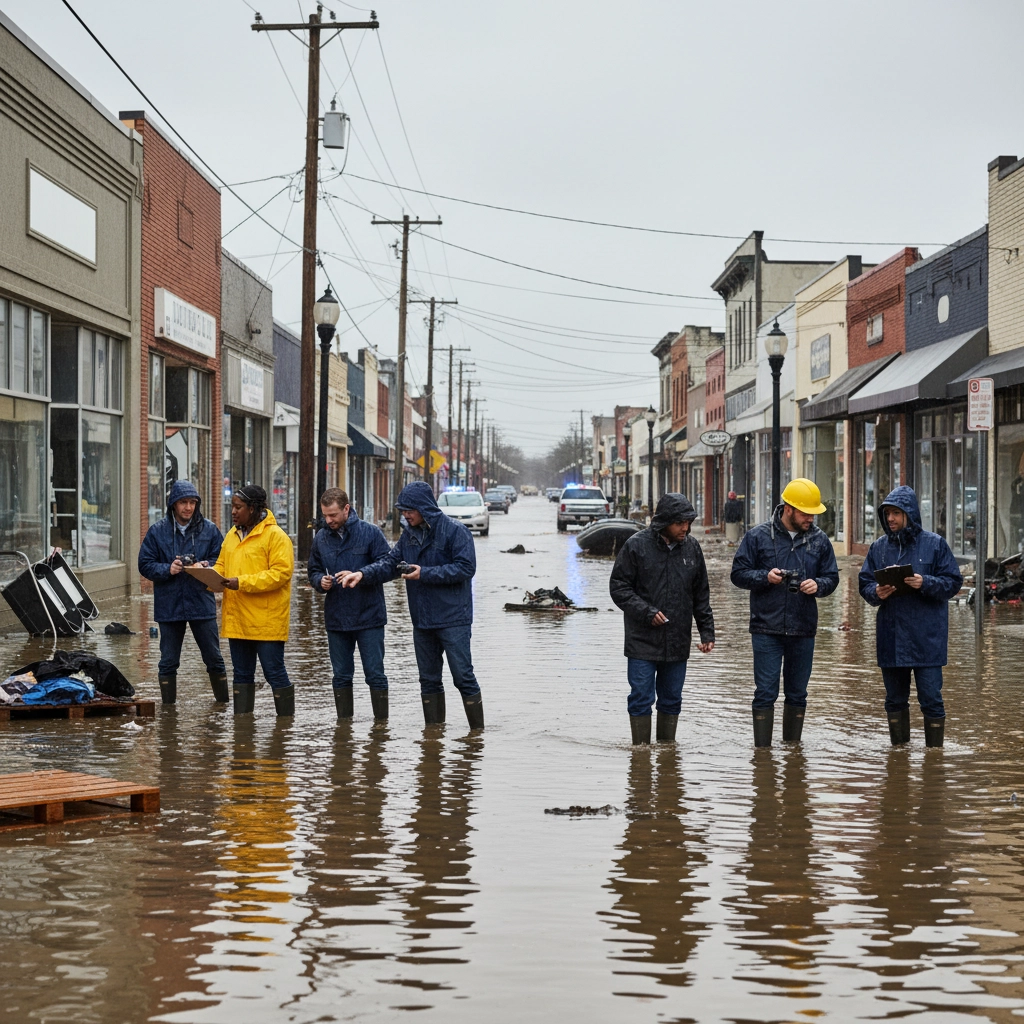Are Your Business Insurance Policies Climate-Ready? The Ultimate 2025 to 2026 Risk Assessment Guide

As we move through 2025, climate change has cemented its position as one of the most significant threats to business continuity. In just the first half of this year, climate-related disasters caused $162 billion in damages globally, with insured losses reaching $100 billion: a staggering 40% increase from 2024. For business owners like you, this reality demands immediate attention to your insurance coverage strategy.
The Allianz Risk Barometer 2025 now ranks climate change as the fifth most significant global business risk, its highest position to date. Yet despite mounting evidence and escalating losses, many businesses remain dangerously unprepared. Recent surveys reveal that while 78% of organizations have experienced climate-related impacts, their response strategies continue to fall short of adequate protection.
Understanding Your Climate Risk Exposure
Your business faces two distinct categories of climate risk that demand comprehensive insurance coverage. Physical risks include the immediate impacts of extreme weather events: hurricanes, wildfires, floods, and unprecedented temperature fluctuations that can devastate your property and operations. Transition risks encompass the financial implications of our global shift toward a low-carbon economy, including regulatory changes, technology disruptions, and evolving market conditions.

Begin your assessment by examining your geographic vulnerability. Climate patterns have fundamentally shifted in recent years, making historical data increasingly unreliable for future planning. Consider how rising sea levels, changing precipitation patterns, and intensifying storm systems might affect your specific locations over the next 18 months.
Your supply chain deserves equal scrutiny. Even if your primary facilities sit in relatively safe zones, disruptions to suppliers, distributors, or transportation networks can create cascading financial impacts. We've seen countless businesses discover too late that their "comprehensive" coverage had gaps in supply chain protection.
Conducting Your 2025-2026 Risk Assessment
Step 1: Map Your Vulnerability Points
Create a detailed inventory of all business assets, including:
- Physical properties and their construction materials
- Critical equipment and technology systems
- Inventory storage locations
- Key supplier and customer locations
- Transportation routes and logistics hubs
Step 2: Analyze Historical and Projected Risks
Review the past five years of weather-related incidents in your operating areas. Then project forward using current climate science data. The National Weather Service and regional emergency management offices provide invaluable resources for understanding evolving risk patterns in your specific markets.
Step 3: Calculate Potential Financial Impact
Quantify what various climate scenarios would cost your business:
- Property damage and replacement costs
- Business interruption losses
- Additional operating expenses during recovery
- Supply chain disruption impacts
- Regulatory compliance costs

Common Policy Gaps That Leave You Vulnerable
Flood Coverage Exclusions
Standard commercial property policies typically exclude flood damage, yet flooding represents one of the fastest-growing climate risks. Even businesses located away from traditional flood zones face increasing vulnerability from flash flooding, storm surge, and overwhelmed drainage systems.
Inadequate Business Interruption Limits
Many policies calculate business interruption coverage based on historical performance, failing to account for extended recovery periods and inflated reconstruction costs following widespread disasters. With climate events becoming more severe and recovery resources stretched thin, your business could face months of operational disruption.
Supply Chain Blind Spots
Traditional coverage often focuses on direct damage to your property while overlooking the ripple effects of supplier disruptions. When a key vendor's facility floods or a transportation hub shuts down due to extreme weather, your business suffers even without direct damage to your own property.
Cyber-Climate Connection
Extreme weather increasingly triggers cyber vulnerabilities as businesses rely on backup systems, remote operations, and alternative communication channels. Many policies fail to address the intersection of climate events and cyber risk, leaving dangerous coverage gaps.
What Makes a Policy Climate-Ready
Forward-Looking Risk Assessment
Climate-ready policies incorporate predictive modeling that considers future climate projections rather than relying solely on historical data. These policies utilize advanced geographic information systems and scenario analysis to price coverage based on evolving risk patterns.
Comprehensive Peril Coverage
Your policy should explicitly address all climate-related perils relevant to your location and industry. This includes named storms, wildfire, flood, hail, extreme temperature events, and secondary impacts like mudslides or wind-driven rain damage.
Adequate Coverage Limits
With reconstruction costs surging following widespread disasters, your coverage limits must reflect current replacement values plus anticipated inflation. Climate-ready policies build in automatic adjustments for cost escalation and market disruption.

Supply Chain Protection
Look for coverage that extends beyond your physical premises to include supplier disruptions, transportation delays, and alternative sourcing costs. This protection proves invaluable when climate events disrupt your business ecosystem.
Technology and Innovation in Climate Risk Management
The insurance technology revolution has transformed how we assess and manage climate risk. Machine learning algorithms now analyze vast datasets to predict potential threats and enable proactive risk reduction rather than purely reactive responses.
Geographic information systems provide granular insights into location-specific vulnerabilities, helping you visualize climate exposure across your entire operation. When combined with predictive analytics, these tools facilitate sophisticated scenario planning that considers multiple climate pathways and their financial implications.
Progressive insurers leverage these technologies to offer more precise coverage that reflects actual exposure rather than outdated assumptions. They can adjust policy terms in real-time as risk profiles evolve, ensuring your protection remains relevant and adequate.
Regulatory Landscape Changes for 2026
The regulatory environment continues to intensify as governments worldwide implement stricter climate disclosure and resilience requirements. European initiatives, including new frameworks for natural catastrophe risk management, emphasize enhanced modeling, improved data sharing, and stronger public-private coordination.
These regulatory shifts create both compliance obligations and opportunities for businesses that proactively address climate risks. Organizations that align with emerging frameworks demonstrate commitment to long-term stability and may benefit from preferential treatment from insurers and regulators alike.

Your Action Plan for Climate-Ready Coverage
Immediate Actions (Next 30 Days)
- Schedule a comprehensive policy review with your insurance advisor
- Document all business assets and their climate vulnerability
- Identify specific gaps in your current coverage
- Request quotes for enhanced climate protection
Short-Term Priorities (Next 90 Days)
- Implement property-level resilience measures to reduce vulnerability
- Develop business continuity plans that address climate scenarios
- Establish baseline metrics for tracking climate exposure
- Consider diversifying your insurance providers to avoid concentration risk
Long-Term Strategic Planning (Next 12 Months)
- Embed climate considerations into all business planning decisions
- Invest in technology platforms that enhance climate data visibility
- Participate in industry initiatives focused on climate resilience
- Regularly update risk assessments as climate science advances
Why Acting Now Matters More Than Ever
The gap between climate-ready businesses and those that delay action continues to widen. Organizations that proactively address climate risks, secure appropriate insurance coverage, and invest in adaptation measures position themselves for greater stability and competitive advantage.
As extreme weather events become more frequent and severe, insurance capacity in high-risk areas may become limited or prohibitively expensive. By addressing your climate readiness now, you secure access to coverage while rates remain manageable and capacity exists.
The question isn't whether climate change will affect your business: it's whether you'll be prepared when it does. Your insurance strategy represents a critical component of that preparation, providing the financial foundation that enables your business to recover and thrive despite climate challenges.
Ready to assess your climate insurance readiness? Contact our business solutions team today for a comprehensive policy review and customized recommendations for your specific risk profile. We're here to help you navigate these complex decisions and secure the protection your business deserves.
#BusinessInsurance #ClimateRisk #RiskManagement #BusinessContinuity #CommercialInsurance #ClimateChange #BusinessProtection #InsurancePolicy #RiskAssessment #BusinessResilience #ClimateAdaptation #InsuranceCoverage #BusinessRisk #ClimateReady #InsurancePlanning #WeatherRisk #BusinessSafety #RiskMitigation #InsuranceReview #ClimateInsurance

No comments:
Post a Comment